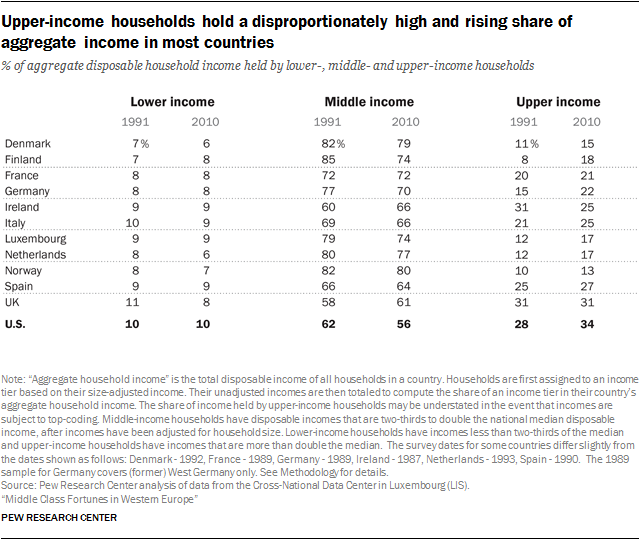The share of aggregate household income held by middle-income households fell in the majority of countries examined from 1991 to 2010.26 This is because, in many of the countries studied, the share of the adult population that is middle income decreased and the upper-income tier experienced a higher rate of growth in income during that time period. The result was an increase in the share of aggregate household income held by the upper-income tier, with the share held by the lower-income tier largely unchanged.
The most substantial shift in the share of aggregate household income from the middle class to the upper-income tier occurred in Finland. The share of that country’s aggregate income held by the middle-income tier fell from 85% in 1991 to 74% in 2010, or by 11 percentage points. This was almost entirely the result of a 7-percentage-point decrease in the middle-income population share in Finland, from 82% in 1991 to 75% in 2010.
Other countries with a notable shift in the share of aggregate income from the middle to the top included Germany and the U.S. In Germany, the share of the middle-income tier in aggregate household income decreased from 77% in 1991 to 70% in 2010 and the share held by the upper-income tier rose from 15% to 22%. In the U.S., the middle-class share of aggregate household income slipped from 62% to 56%, while the upper-income share increased from 28% to 34% from 1991 to 2010.27
Ireland and the UK are the only countries in which the shares of aggregate household income held by the middle class increased from 1991 to 2010. With the share of the middle-income population rising substantially in Ireland, the middle-class share in income also increased, from 60% in 1991 to 66% in 2010. Similarly, a bigger middle class in the UK pushed its share of aggregate household income from 58% in 1991 to 61% in 2010.

The reduction in the share of aggregate household income held by middle-income households continued through 2013 in most of the countries for which data are available. In the Netherlands, the share fell from 77% in 2010 to 75% in 2013, and in the U.S. the share fell from 56% to 54%. But the share inched up by about 1 percentage point each in Finland and the UK (see Appendix A).
The size of the middle class in a country and the share of aggregate income held by the middle class are closely correlated. Countries with smaller shares of adults in middle-income households, such as Ireland, Italy, Spain, the UK and the U.S., are also the countries in which the middle-class shares of aggregate income are smaller than in other countries. At the other end, countries with relatively large middle-classes, such as Denmark, Finland, the Netherlands and Norway, also have higher shares of aggregate household income in the hands of middle-class households.




